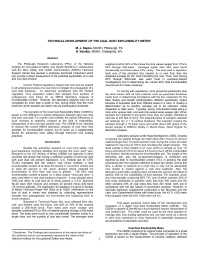Mining Publication: Technical Development of the Coal Dust Explosibility Meter
Original creation date: January 2006
The NIOSH Pittsburgh Research Laboratory, in collaboration with MSHA Technical Support, has devised a prototype handheld instrument that can provide a direct assessment of the potential explosibility of a coal and rock dust mixture. Current federal regulations require that rock dust be applied in all underground areas of a coal mine to mitigate the propagation of a coal dust explosion. To determine compliance with the regulations, mine inspectors collect dust samples from sections of underground coal mines for an MSHA laboratory analysis of incombustible content. However, the laboratory analysis may not be completed for more than a week or two, during which time the mine areas from which samples are taken may be inadequately protected. The operation of the coal dust explosibility meter (CDEM) is based on the difference in optical reflectance between light rock dust and dark coal dust. For a given coal volatility, the optical reflectance of such mixtures is relatively constant at the limit of explosibility, independent of the coal dust particle size. The CDEM is not intended to replace the current MSHA laboratory analysis of coal mine dust samples for incombustible content, but rather to serve as a supplemental device for enhancing mine safety through improved rock dusting practices.
Authors: MJ Sapko, HC Verakis
Conference Paper - January 2006
NIOSHTIC2 Number: 20029909
2006 SME Annual Meeting and Exhibit, March 27-29, St. Louis, Missouri, preprint 06-044. Littleton, CO: Society for Mining, Metallurgy, and Exploration, Inc., 2006 Mar; :1-5
See Also
- Coal Dust and Methane
- Coal Dust Explosibility Meter Evaluation and Recommendations for Application
- Field Evaluation of the Coal Dust Explosibility Meter
- How Does Limestone Rock Dust Prevent Coal Dust Explosions in Coal Mines?
- How to use the Coal Dust Explosibility Meter
- Particle Size and Surface Area Effects on Explosibility Using a 20-L Chamber
- Preventing Coal Dust Explosions in Underground Coal Mines
- Rock Dusting
- Rock Dusting Considerations in Underground Coal Mines
- Technology for Real-Time Monitoring of Coal Dust Explosion Hazards
- Page last reviewed: 9/21/2012
- Page last updated: 9/21/2012
- Content source: National Institute for Occupational Safety and Health, Mining Program


 ShareCompartir
ShareCompartir
